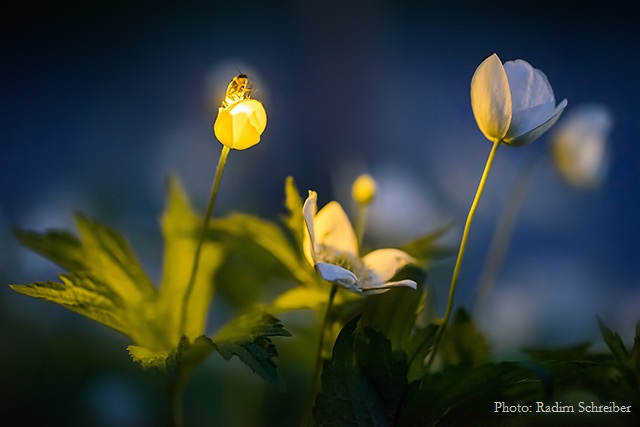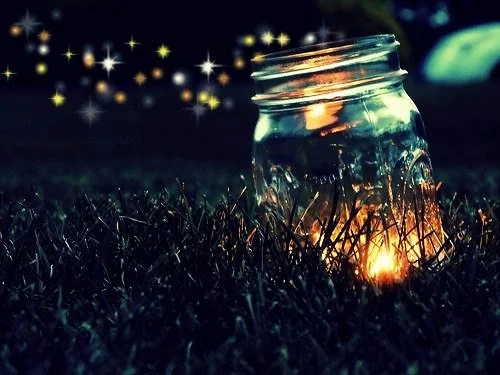Updated June 18, 2023
Firefly illuminating Wood Anemone by Radim Schreiber - view more stunning images at The Firefly Experience.
“In her flowy nightgown and bare feet, she rushed headlong into the summer night to witness one of the most magical displays of nature – a field of fireflies!”
One of my most treasured memories from a childhood in Maine is watching those magical “lightning bugs” or fireflies light up a field at night.
I remember how comforting it felt to have the emptiness of an ink-black night interrupted by the fairy-like twinkling of countless fireflies announcing their place in the world.
The Sense of Awe and Wonder.
The trance of the dancing lights, just out of reach – almost beyond the veil of this world.
And then, of course, if you were lucky enough you would capture one and marvel at the bottled magic in a jar beside your bed as it hypnotized you to sleep (the poor things, imprisoned in glass).
In my adult years, I’ve noticed far fewer of these enchanting insects enhancing our summer nights. A lot of my friends and family have made the same observation.
This is why I was so happy to see a good, respectable number in our small meadow the other night. My 9-year daughter, offspring to not one – but two biologists – is following in her parent’s footsteps already.
She has a deep fascination with all things wild.
Needless to say, she was delighted with the chance to postpone bedtime and to explore a new natural wonder with Mama when I called inside: “Honey! Come out and see all the fireflies!!"
In her flowy nightgown and bare feet, she rushed headlong into the summer night to witness one of the most magical displays of nature – a field of fireflies!
We crouched down on the edge of the driveway and watched their lights, flashing across our tall grass and bushes.
We held hands and whispered and watched. It was a moment I’ll never forget.
So, what’s changed?
Why are we seeing fewer fireflies?
A lot of it has to do with habitat loss caused by increased development and our American obsession with massive lawns and “tidy” landscapes.
In our case, we are seeing more fireflies because we’ve recently let parts of our lawn “go”. We even had a neighbor ask us the other day, “do you guys even mow?!”
In some places we do, in others we only mow once a year.
In one of our low-mow areas we now have a lovely little meadow under our apple trees that, despite its small size, is delivering big rewards.
We enjoy the blooming wildflowers by day and the tall vegetation supports more fireflies for us to enjoy at night.
What can YOU do to attract more fireflies to your patch of land?
Five Easy Ways to Create Firefly Habitat
1) Let it Grow & Create Cover
Allow areas of your lawn or landscape to go wild. The tall grass and plants that develop there will provide “cover” for fireflies during the day when they are inactive and resting, and need to avoid predators. You can mow these areas once a year - in late winter or early spring, ideally (hallelujah: less work!). Shrubby/brushy edges along your woods are also good. Fireflies prefer moist areas and thrive in wet meadows, bogs, marshes, and wetland edges, so try to select moister sites for enhancing habitat.
2) Avoid Chemicals & Let Them Live
Don’t use chemicals on your lawn/yard. Many products marketed for our lawns/yards are insecticides designed to kill insects (because some of them are considered “pests”) but these chemicals don’t discriminate and can kill fireflies too. Many organic solutions exist for common pest problems.
3) Go Dark & Let Their Light Shine
Artificial lighting has negative effects on fireflies (and moths), so make sure if you have a porch light it’s on a motion sensor and there are minimal lights polluting the dark night. Natural darkness will attract them to your space because they are free to communicate with one another via bioluminescence.
4) Leave Debris - Let It Be
We may have 20-30 different species of fireflies in New England, and many of these need downed woody material like rotten logs and fallen tree branches or leaf litter to complete their life cycle. Resist the temptation to “clean up” your wooded edges and forested areas and you’ll be providing habitat by doing literally nothing!
5) Embrace Slime So They Can Dine
Like many insects, fireflies undergo a metamorphosis. In their larval form, they feed on grubs, snails, slugs, and worms. They need this food in order to become the beautiful adult fireflies we all love to see. Who knew that slime could be at the root of such beauty?! Allow some of these slimy creatures to live on your landscape, while enjoying the service larval fireflies provide by preying on common garden pests like slugs and Japanese beetle grubs.
+ NEW INFORMATION BELOW!
Want to delve even deeper into fireflies and what they need?
The wonderful Nancy Lawson has a highly informative article on The Humane Gardener:
Did you know? Fire “flies” are actually not flies at all, but winged beetles in the family Lamphyridae (note the root word “lamp”, from the Greek word lampein, which means “to shine”).
SIGN UP TO RECEIVE FREE TIPS, TOOLS, AND INSIGHTS FOR BUILDING HABITAT AND HOPE.
#ThePersonalEcologist
I co-create biodiverse habitats with eco-minded stewards throughout the Northeast - at any scale.
I have 30 years of experience and a lifelong commitment to wildlife conservation.
Read My Story.
-
Deborah
Perkins
- Jan 8, 2026 Carnivore Coexistence (Leopold's Wise Words - Part 1)
- Oct 31, 2025 Hallowed Habitat
- Dec 22, 2023 Storm Habitat: Nurse Logs, Dens, and More
- Aug 8, 2023 Beautiful Buttonbush in Bloom
- Jun 17, 2023 Snapping Turtles on the Move
- Feb 1, 2023 The True Harbingers of Spring: Chickadees
- Mar 20, 2021 The Power of Photoperiod
- Feb 19, 2021 The Golden-crowned Kinglet: A Royally Charming Winter Resident
- Feb 8, 2021 Subnivean Secrets
- Jan 9, 2021 Wild Reads: Ravens in Winter
- Oct 23, 2020 Flower “Beds” for Bumble Bees
- Oct 4, 2020 Wise Oaks, Clever Jays
- Sep 11, 2020 Goldenrods: Top Plants for Boosting Biodiversity
- Aug 25, 2020 Gentle Golden Wasps Adorned with Pollen
- Aug 1, 2020 Water for Wildlife - Birdbath Basics & More
- Jul 19, 2020 Fruits of the Forest
- Jul 11, 2020 Hungry Little Hummingbirds
- Jun 24, 2020 Hatching Out: Mother Nature's "Escape Room"
- Jun 12, 2020 Maine's Real Lupine Revealed
- May 31, 2020 Wild Geranium in Flower
- May 24, 2020 Moosewood Chandeliers
- May 17, 2020 Shadbush in Bloom
- May 7, 2020 Native Nectar for Queen Bumble Bees
- Apr 25, 2020 Waves of Warblers
- Apr 19, 2020 Attracting Bluebirds without Boxes
- Apr 12, 2020 Hungry Bears on the Move
- Apr 5, 2020 Bees on Red Maple Flowers
- Mar 27, 2020 Sky Dancing
- Mar 22, 2020 Fox Kits Being Born
- Mar 15, 2020 Corvids a-Courtin’
- Mar 8, 2020 Phenology Notes: Witnessing The Seasons of our Wild World
- Feb 5, 2019 Plan Your Habitat Garden
- Jan 2, 2019 Wild Reads: We Took to The Woods
- Nov 28, 2018 Winterberry: The Gift that Keeps on Giving
- Aug 16, 2018 Where Have All the Whip-poor-wills Gone?
- Jun 22, 2018 Give a Warm Welcome to Wild Bees (Super-pollinators Part 2)
- May 16, 2018 The Wonder of Wild Bees (Super-pollinators Part 1)
- Apr 19, 2018 Saving Songbirds Starts with Your Morning Coffee
- Mar 21, 2018 Wildlife Habitat Design in A Wounded World
- Feb 16, 2018 “Intelligent Tinkering” - How to Boost Biodiversity at Home (Leopold’s Wise Words Part 2)
- Dec 14, 2017 Dead and Dying Trees are Key to Life
- Nov 14, 2017 A Top Threat to Biodiversity: Invasive Plants
- Sep 21, 2017 Beechnuts - Superfood for Bears & Other Wildlife
- Aug 22, 2017 Baby Bats Need Love Too
- Jul 25, 2017 Bring the Magic of Fireflies Back Home Again





